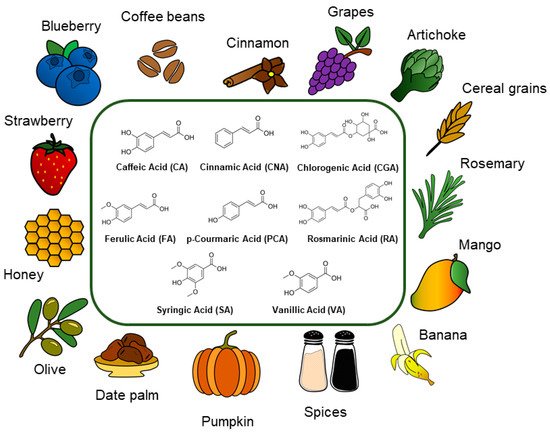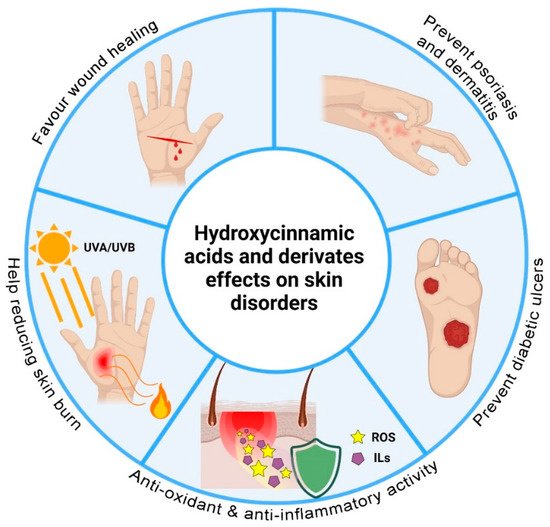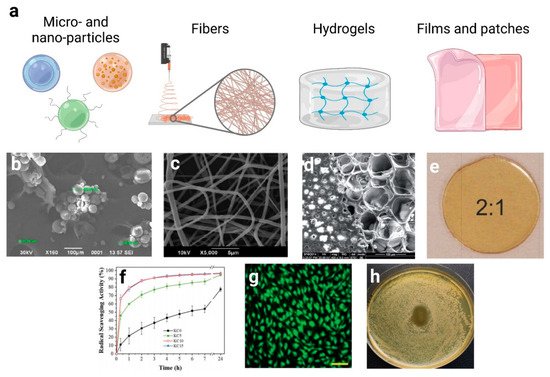Alterations of skin homeostasis are widely diffused in our everyday life both due to accidental injuries, such as wounds and burns, and physiological conditions, such as late-stage diabetes, dermatitis, or psoriasis. These events are locally characterized by an intense inflammatory response, a high generation of harmful free radicals, or an impairment in the immune response regulation, which can profoundly change the skin tissue’ repair process, vulnerability, and functionality. Moreover, diabetes diffusion, antibiotic resistance, and abuse of aggressive soaps and disinfectants following the COVID-19 emergency could be causes for the future spreading of skin disorders. In the last years, hydroxycinnamic acids and derivatives have been investigated and applied in several research fields for their anti-oxidant, anti-inflammatory, and anti-bacterial activities.
1. Introduction
Skin is the tissue dedicated to the protection of the inner part of the body. It acts as a sensor for most of our sensations, such as the sense of temperature and pressure. This tissue can often undergo injuries, infections, or stresses, constantly being exposed to external agents and events
[1].
Skin disorders and damages are emerging as one of the most troubling and challenging conditions for the healthcare systems in terms of rising cases, management, and correlated costs
[2][3][4][2,3,4]. Acute and chronic wounds, diabetic ulcers, burns, psoriasis, and atopic dermatitis (AD) are the most diffused and alarming impairs of the skin tissue involving thousands of millions of people worldwide
[5][6][7][5,6,7]. These conditions are connected with either genetic factors, metabolic alterations, environmental factors and lifestyle, injuries, or a combination thereof. Antimicrobial resistance is also playing a significant role in the development of secondary effects and in enhancing these alterations, aggravating the patients’ prognosis
[8]. The concurrent abuse of soaps and hand disinfectants due to the COVID-19 pandemic might even support the onset of new disorders tightly connected with skin health and homeostasis modification. Indeed, the use of aggressive soaps and disinfectants can alter the equilibrium of the microbial environment, usually present in healthy skin, and modify the local pH, becoming a source of stress and irritation for the skin
[9][10][9,10].
All these alterations are characterized mainly by the presence of a high concentration of free radicals and/or abnormal inflammatory response. For instance, after a burn event, a massive amount of reactive oxygen species (ROS) is generated. They can propagate the damage not only at the local but also to a systemic level, affecting other tissues and organs. This event recalls inflammatory cells, which can consequently contribute to increasing the ROS local and systemic generation.
[11]. A similar scenario can be found in chronic diabetic ulcers, where the wound healing process is profoundly modified by the persistent hyper-glycemia condition. Here, a chronic inflammatory response is present, and an enormous quantity of inflammatory mediators and ROS are constantly released
[12]. However, it is difficult to find a single molecular target due to the overlap of several altered molecular and metabolic pathways. Likewise, in dermatitis and psoriasis, the physiological alterations of the skin are attributed to upregulation of the release of pro-inflammatory mediators, such as chemokines and cytokines, requiring the use of anti-inflammatories such as corticosteroids
[13][14][13,14]. In this scenario, natural compounds are gaining attention in the scientific and industrial communities due to their biocompatibility, anti-oxidant, anti-inflammatory, and antimicrobial properties
[15][16][17][18][15,16,17,18]. Among these compounds, hydroxycinnamic acids and their derivatives have been explored in several fields such as food packing
[19], cosmetics
[20], pharmaceuticals
[21], and nutraceuticals
[22].
Biomedical nanotechnologies can offer great help in the improvement of phenolic stability, duration, bioavailability, and delivery at the site of action, to allow efficient exploitation of the compound’s therapeutic properties
[23][24][23,24]. Currently, eligible biomaterials for this kind of application require several characteristics and should be selected case by case, depending on the different physio-pathological conditions that each skin injury or disorder presents.
Other reviews have already faced the importance of the hydroxycinnamic acids and derivatives for other specific applications such as cosmetics
[20], their pharmacodynamics
[25], pharmacokinetics
[26], and toxicity
[27].
2. Hydroxycinnamic Acids and Derivatives: General Uses and Current Applications
This class of compounds is synthetized via the shikimate pathway, a metabolic route used chiefly by plants but also fungi and algae. These molecules are involved in several functions inside the cells, which will be discussed in this section. In this review, we will focus our attention on cinnamic acid (CinAc), ferulic acid (FA), p-coumaric acid (PCA), caffeic acid (CA), vanillic acid (VA), syringic acid (SA), rosmarinic acid (RA), and chlorogenic acid (CGA). The chemical structures of these molecules are shown in Figure 1.
Figure 1. Schematic representation of the phenolic acids’ structures and their main source.
3. Hydroxycinnamic Acids and Derivatives: Activities on Skin Disorders
Skin is the largest organ of the body and, as a consequence, it can be easily subjected to some damages, which alter the normal physiology of this important barrier. Wounds, burns, dermatitis, and psoriasis represent the main skin disorders. In this section, the potential of the hydroxycinnamic acid derivatives as pharmacological molecules in the treatment of skin diseases will be extensively discussed. The schematic representation of the various actions of hydroxycinnamic acids and derivatives toward skin disorders is illustrated in Figure 2.
Figure 2. Schematic representation of the effects of the hydroxycinnamic acids and derivates on skin disorders created with
BioRender.com (accessed on 15 May 2021).
4. Hydroxycinnamic Acids and Derivatives: Advanced Formulations
Poor solubility in water, crystallinity, instability to oxidation, and tissue penetration are the main drawbacks that require to be addressed in the design of advanced micro- and nano-materials. In this last section, we will report the most diffused approaches for fabricating formulations and active biomaterials for the treatment of skin disorders. The main strategies used for this purpose are schematized in Figure 3.
Figure 3. (
a) Schematic representation of the principal nanocarriers exploited in the treatment of skin disorders created with BioRender.com (accessed on 15 May 2021). (
b) SEM image of phyto-vesicles made of soy lecithin and cholesterol loaded with rosmarinic acid.
[28][208] Copyright
®2020 with permission from Elsevier. (
c) SEM image of PVP/keratin nanofibers loaded with cinnamon essential oil
[29][213]. This article is licensed under a Creative Commons Attribution-NonCommercial 3.0 Unported Licence, Published by The Royal Society of Chemistry. (
d) Surface/cross-section SEM image of caffeic acid/gelatin-based hydrogels. Adapted from
[30][229] with permission from The Royal Society of Chemistry. (
e) Photograph of a transparent PVP/PCA-based film with a weight ratio 2:1. Adapted from
[31][243] with permission from The Royal Society of Chemistry. (
f) Anti-oxidant capacity of PVP/keratin/cinnamon essential oil-based nanofibers in a radical scavenging assay.
[29][213] This article is licensed under a Creative Commons Attribution-NonCommercial 3.0 Unported Licence, Published by The Royal Society of Chemistry. (
g) Fluorescence image of NIH 3T3 fibroblast cells adhering and proliferating inside a caffeic acid/gelatin-based hydrogel. Adapted from
[30][229] with permission from The Royal Society of Chemistry. (
h) Anti-bacterialefficacy of a PVP/PCA-based film against
Escherichia coli. Adapted from
[31][243] with permission from The Royal Society of Chemistry.



